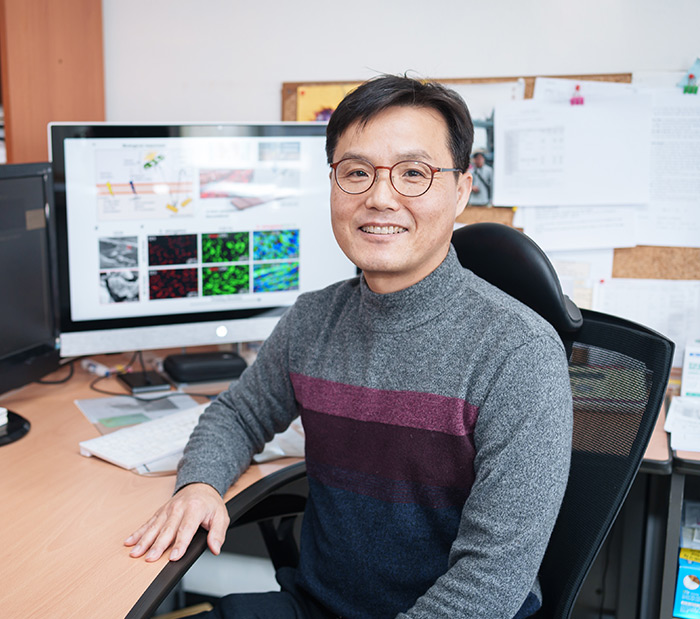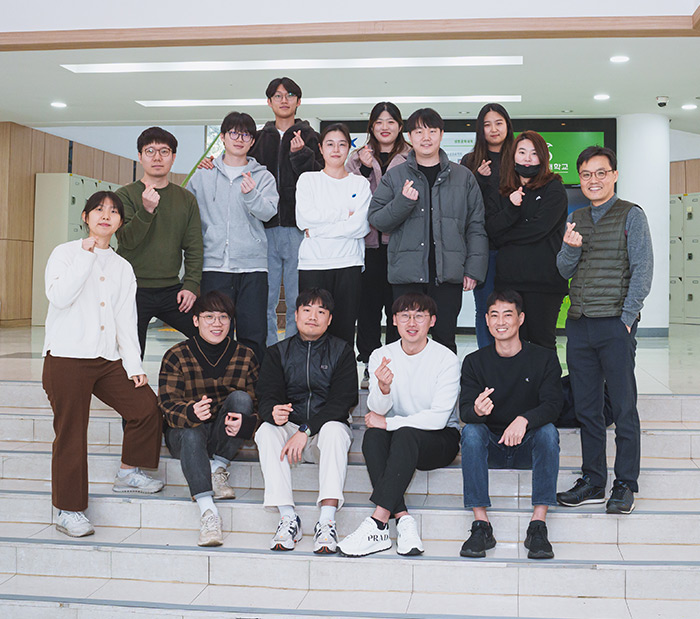Research Stories
Employment of photosynthetic bacterium for hypoxia prevention and efficient myogenesis in muscle tissue regeneration
Development of oxygen-generating cyanobacteria-laden bioink and utilized in situ E-field assisted bioprinting system to rescue the cells in 3D printed constructs from hypoxic conditions for regenerating skeletal muscle tissue by Prof. Geun Hyung Kim, Dr. Hyeongjin Lee, Mr. Hanjun Hwangbo of Bio-mechatronic engineering
Bio-Mechatronic Engineering
Prof.
KIM, GEUNHYUNG
Dr. Hyeongjin Lee, Mr. Hanjun Hwangbo
Inadequate oxygen delivery to the macroscale 3D cell-constructs of regenerating skeletal muscle tissue has remained a multiplex issue owing to the pivotal factors such as cell metabolism and several regulatory intercellular pathways that eventually influence various cellular activities and determines cell phenotype. In addition, continuous metabolic activities of cells in 3D bioconstructs could evoke accumulation of reactive oxygen species (ROS) and induce cellular damage via oxidative stresses.
To overcome this issue, the research team led by professor Geun Hyung Kim in Biomechatronic engineering department has developed oxygen-generating cyanobacteria-laden bioink and utilized in situ E-field assisted bioprinting system to rescue the cells in 3D printed constructs from hypoxic conditions for regenerating skeletal muscle tissue. Various factors such as cyanobacteria concentrations, LED light exposure and E-field were considered to optimize the developed system. As result, owing to the synergistic effects of the bioactive microenvironment that rescues cells from hypoxic conditions and activations of voltage-gated ion channels, highly aligned, multi-nucleated myofibers are obtained as well as significant upregulation (7–10-fold) of myogenic-related genes compared with conventionally prepared cell-constructs.
Prof Kim states, "Based on these promising results, the combined effects of oxygen-generating cyanobacteria as a bioactive constituent of the bioink and simultaneous E-field-supporting bioprinting can offer an effective treatment strategy against severe skeletal muscle defects."
To add, he states, “unlimited to muscle tissues, it can also be used as an effective artificial organ production system for various tissue regeneration which requires oxygen supply.”
The described study was published in Advanced Functional Materials (IF = 19.924) in December of 2022 under support from the National Research Foundation of Korea (NRF) funded by the Ministry of Science and ICT for Bioinspired Innovation Technology Development Project (NRF-2018M3C1B7021997) and grant from the Ministry of Trade, Industry & Energy (MOTIE, Korea) under Industrial Technology Innovation Program (20009652, Technology on commercialization and materials of Bioabsorbable Hydroxyapatite less than 1 micrometer in size).
※Paper: Photosynthetic Cyanobacteria can Clearly Induce Efficient Muscle Tissue Regeneration of Bioprinted Cell-Constructs (https://doi.org/10.1002/adfm.202209157).
Figure 1. Schematic diagrams of printing process and biological response of cells to in situ E-field stimulation and oxygen-generating cyanobacteria.


